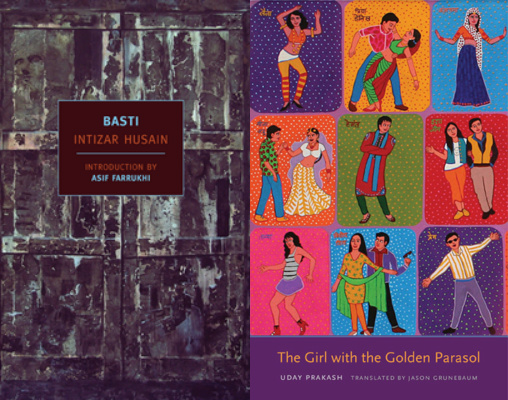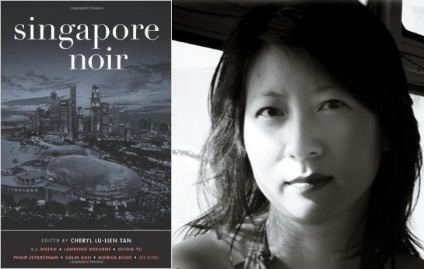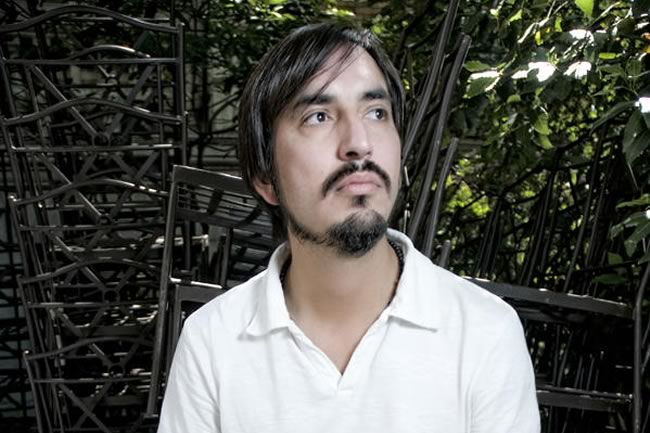You won’t see her on any wanted posters, but literary police officers have made a composite image of Russian femme fatale, Leo Tolstoy’s Anna Karenina (the endeavor reminds us how little we know about our favorite characters’ physical appearances—and why things are better that way). Anna’s popularity came as quite the surprise to many Russian readers at the time, who thought Tolstoy was just too, well, Russian to garner much readership outside his native country. READ MORE…
Weekly News Roundup, 15th August 2014: Anna Karenina’s Face; Happy 30th, Dalkey!

This week's literary highlights from across the world
On the Dearth of South Asian Translations in the U.S. (Part II)

How some South Asian translations are making it—or trying to, at least—in the brutal U.S. publishing market
Read all posts in Mahmud Rahman’s investigation here.
Daisy Rockwell is a painter, writer, and translator. From 1992-2006, she made a detour into academia, from which she emerged with a Ph.D. in South Asian literature and a book on the Hindi author Upendranath Ashk. She had become interested in his writing as a grad student.
In an interview with CNN last year, she said: “Ashk asked me to undertake a short story collection shortly before his death, which I did somewhat reluctantly as I was more interested in translating his long novel, Falling Walls (something I’m finally working on now). It ended up being his dying wish to me, however, so I saw the project through. I finished most of the work around 2000, but had a very hard time finding a publisher, even in India.”
Her translation of Ashk’s Hats & Doctors came out from Penguin India in 2013. About her approach to U.S. publishers, she wrote: “I have tried and so far failed to get my translation published in the U.S., on numerous occasions. I have another work forthcoming and I will try with that too. We’ll see what happens. I haven’t had any explanations. So far I’ve approached them myself. Next up, my agent. Mostly I’ve tried academic presses and small presses. I haven’t tried that many, but since no one maintains a South Asia list, really, the entire thing feels kind of scatter shot and I’ve gotten discouraged easily.” READ MORE…
What We’re Reading in August

Featuring Eridanos Library favorites, tales of primeval and Mongolian displacement, and an anthology of stories about knock-offs!
József Szabó (technical manager): Of the books I’ve read during the past few months, Hans Erich Nossack’s An Offering for the Dead (trans. Neugroschel) has become a book I highly regard. It was my slow but steady mining of the out-of-print Eridanos Library series that led me to this short novel, whose not-so-familiar author stood out from the others in the set, such as: Heimito von Doderer, Michel Leiris, Piñera, Klossowski, Landolfi, Akutagawa, Savinio, Musil.
An Offering, stylistically, reads as if (Hamburger’s) Celan wrote a ~120-page surrealistic threnody in prose for European victims of a WWII bombing. READ MORE…
Translation Tuesday: “The Stops” by Artur Azevedo

A comedic piece about a missed connection by a 19th-century Brazilian master
Norberto, who at first enthusiastically accepted the stops the streetcars made in Botafogo, is now their greatest opponent. Do you want to know why? I will tell you:
One night, at the Expo, the poor young man met the most beautiful and fascinating woman his eyes had ever beheld, and this woman—oh, joy!…oh, fortune!…—this woman smiled gently at him, and with a sweet look she invited him to accompany her.
Norberto did not wait for the invitation to be repeated: he accompanied her.
She stepped into the Avenue of the Pavilions, made her way to the entrance, and went out as if she were going to take the streetcar; he followed her, but there were so many people leaving that he lost sight of her.
Desperate, he ran for the streetcars, some six or seven being ready to depart, and he climbed onto all the side-rails, searching in vain, with eyes peeled for the unknown beauty.
Weekly News Roundup, 8th August 2014: Slang-xplaining, Winning Prizes and Judging Them

This week's literary highlights from across the world
Prescriptive grammarians may enjoy this, even if it destabilizes their strict sense of right and wrong: Slate has detailed the 250-year-long grammatical quibble over the correct use of “hopefully,” that ever-present eye twitch of incorrect adverbial usage. Also related: the same website explains why certain adjectives just sound right in one way, and not the other. If your eyes aren’t tearing up with that twitch yet, take a look at io9′s ambitious compilation of the most disastrous typos in Western history.
Meanwhile, in the same spirit of chronological grammar-mapping, The Atlantic has compiled a web app history of the New York Times’ stiff slang explanations (example: “Diss, or a perceived act of disrespect”). And the game-side disputes can finally end: Scrabble has added over five thousand new terms to its updated player dictionary, including such witticisms as “sudoku” (shouldn’t that be a proper noun?), “buzzkill,” and “vlog.”
July Issue Spotlight: Sergio Chejfec’s “The Witness”

A close look at Sergio Chejfec's masterful not-quite fiction, non-quite essay, "The Witness"
Patty: The phrase “of-the-moment” is so annoyingly trite, but for lack of a better expression, Sergio Chejfec is perhaps one of today’s most of-the-moment writers, and the short fiction/systematic essay-musing “The Witness”—translated by Steve Dolph and published in Asymptote’s July issue as part of our Latin American feature—proves beyond a shadow of a doubt just why that is.
They say, more or less, that anyone who’s made the mistake of leaving can’t make the mistake of returning. READ MORE…
Crime on the Island: Interviewing Cheryl Tan of “Singapore Noir”

An interview with Cheryl Tan, editor of the first Singaporean crime fiction anthology published in the United States
Singapore has one of the world’s lowest homicide rates, but much like its partner in (low) crime, Iceland, it’s fertile ground for noir stories. Launched this month, ten years after the release of Brooklyn Noir, is Brooklyn-based Akashic Books’ newest title in its bestselling series of Noir anthologies, Singapore Noir, edited by the Singaporean writer Cheryl Lu-Lien Tan, a former staff writer at the Wall Street Journal and author of A Tiger in the Kitchen: A Memoir of Food and Family.
Nicole Idar: Singapore is the fourth Asian city to boast an Akashic Books Noir anthology, after Delhi, Manila, and Mumbai (Seoul is forthcoming). Can you tell us how Singapore Noir came about?
Cheryl Tan: I’d long admired New York publisher Akashic Books’ award-winning Noir series—a series of anthologies, and there are dozens by now, each one set in a country or a city. Brooklyn Noir was a personal favorite but you also have everything from Baltimore Noir to Paris Noir. Some really big names have edited these collections of dark stories set in these locales—Joyce Carol Oates edited New Jersey Noir, for example, and Dennis Lehane edited Boston Noir.
In November 2011, I was at the Miami Book Fair, speaking about A Tiger in the Kitchen, my first book. At the authors’ party, mystery writer extraordinaire S.J. Rozan introduced me to Johnny Temple, Akashic’s publisher. I told Johnny how much I loved his noir series but asked why there hadn’t been a Singapore Noir. He said it was because he didn’t know any Singaporean writers. And S.J. said, “Well now you do.”
Translation Tuesday: “Obituario (El estudiante)”

"His last words—how to explain without telling her the rest?—had not come out of his mouth."
When it was all over, the mother knocked on the door to my office. She sat down in the only chair that faced mine from the other side of the desk, in the same place where the student had been a few minutes before he fell to the floor. To mask my discomfort, I offered her a box of tissues and she wiped her eyes. I had been the last person to see him the way she would have wanted to remember him. Now it would be impossible after the legal process, the photos, the morgue, and the many stories in the newspapers. She told me about his last few months, avoiding all uncomfortable commentary. Suddenly she paused. She wanted to know what his last words had been. I inhaled deeply: his last words—how to explain without telling her the rest—had not come out of his mouth.
On the Dearth of South Asian Translations in the U.S. (Part I)

“It’s a serious problem when so few titles and literature from so few languages find their way to American readers.”
Read all posts in Mahmud Rahman’s investigation here.
Until about ten years ago, whenever I visited Bangladesh, a journey “home” every three to five years, I would make my way to a small bookshop in Dhaka’s New Market. Zeenat Book Supply was one of the few places that carried English titles from India. There were better shops for books in Bangla, and subcontinental writing in English I could find in the U.S. What I sought at Zeenat was books in translation. These would sometimes be wrapped in plastic, other times coated with dust, the edges dirt-brown. Here I would find fiction that had originally been written in languages I didn’t know: Hindi, Tamil, Malayalam.
When I had the good fortune to visit Calcutta, I would discover more.
What discoveries I returned with! Raag Darbari, Shrilal Shukla’s biting small-town satire. Karukku, Bama’s brave memoir as a Dalit Christian. Desert Shadows by Anand that took me into the corrupt world of an Indian prison.
Unless a used copy lands somewhere by chance, such books are not found in U.S. bookstores. Unless you were teaching Indian literature or someone who keeps up on South Asian writing outside English, you would probably not know about these titles.
Krumping in Translation: Interviewing Aditi Machado, Asymptote’s Poetry Editor

On reading translated poems: "It’s a dangerous, unsettling world—that’s why it’s fun."
Asymptote’s poetry editor Aditi Machado has curated across the gutter and five continents. In light of Asymptote’s July issue, I interviewed Aditi, and her responses run the gamut: what follows is an in-depth interview with insight into arranging an issue, poetry in translation, and embracing vulnerability when reading.
Many think that reading poetry requires a specific literacy—is the same true for reading translation, or poetry in translation?
Reading anything requires specific forms of literacy, even reading a newspaper. With poetry, I think we’re less aware of skills we may already have or of those that may be gained. Additionally, we’re extremely sensitive about our lack in these skills—or, if we feel we do have them, we might be able to articulate how we learned them and how much further we have to go. It’s a special privilege, being literate about one’s literacy. READ MORE…
Translation Tuesday: “A Brief Life” by Carlos Labbé

A young man's decidedly uncanny encounter at the beach
One summer I was at a beach in Mar del Plata with a group of young Argentine friends, around ten men and women, the majority attractive, at an age with more than enough time to spend hours arguing about unimportant matters as if they were the most profound things in the world. I remember that I was fresh out of University and had traveled to Argentina for the summer. My principal interlocutor, strangely, seemed older than I, although in reality he was quite young. He was bolder in the discussion, he seemed to know the names of many more books and authors, his hair was long, his voice husky, his face angular, his body athletic. He was drinking maté and his name was Julio. Everyone else was lying around on towels with dark sunglasses, bikinis, beers, CDs, and cigarettes. Every now and then one of them would enliven the discussion with a favorable comment for Julio or for me, with objections or laughter.
– No, loco, you’re wrong. Or, are telling me you want to write like Oliverio Girondo? Man, you’re bitter.


